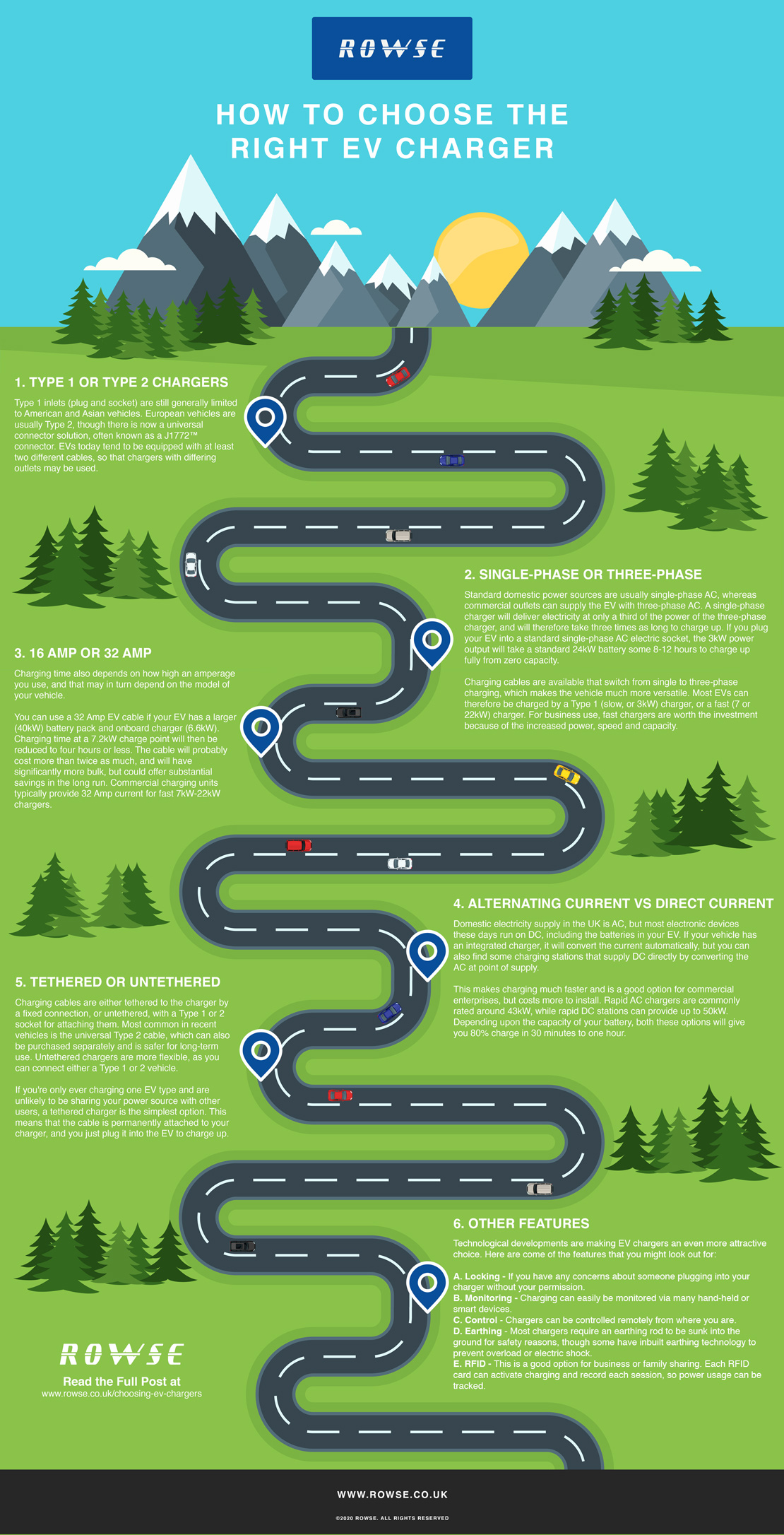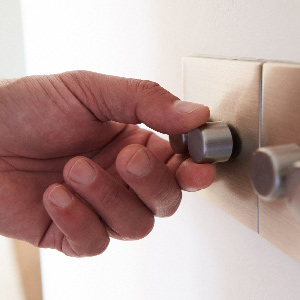How to Choose The Right EV Charger
Post By: Ryan King On: 02-03-2020 - Home Automation - Industry Trends - Smart Homes

Electric vehicles are getting more technologically advanced every day. Their use is no longer so limited, making clean energy a real possibility, and EV owners are beginning to consider their options for commercial and home charging.
Do you know how to choose the right EV Charger? While you'll still use external charge points when you're on the move, you'll also want to charge up your vehicle while not in use. This offers various opportunities for assessing electricity charge rates, battery types and so on.
The main considerations that should be taken into account when choosing an EV Charger are:
- Type 1 or Type 2
- Single Phase or Three Phase
- 16 Amp or 32 Amp
- AC vs DC
- Tethered or Untethered
- Other Features
1. Type 1 or Type 2 Chargers
Your choice depends largely on where you're based and what model vehicle you're charging. Type 1 inlets (plug and socket) are still generally limited to American and Asian vehicles. European vehicles are usually Type 2, though there is now a universal connector solution, often known as a J1772™ connector. EVs today tend to be equipped with at least two different cables, so that chargers with differing outlets may be used.
Choosing the right EV charger depends on how far you want to travel, and how long you want to spend charging. There is also the consideration of electricity costs, and how to take advantage of off-peak rates, but initially the choice is between Level 1 or Level 2. Level 1 chargers use less voltage, amperage and kilowatts, but the number of hours required to charge your vehicle is substantially more. If you charge your EV on a smart system, you may be able to access converted solar energy, and use charging plans that you can schedule to maximise off-peak savings.
It also depends on whether you're charging a single domestic vehicle or running a business, where Level 2 chargers will support a network of several vehicles charging simultaneously. The range of travel is a factor too, with Level 1 charging contributing only about four miles RPH (Range Per Hour), while Level 2 charging supplies 12-60 miles RPH.
For a commercial business, Level 1 chargers are generally too slow, as it takes almost a whole day to charge an EV. These work better for domestic use. Level 2 charging allows multiple drivers to be served per day, allowing them to access more customers. Drivers can find networked Level 2 stations through mobile apps, while business owners can take advantage of power-sharing and the latest software updates.
2. Single-Phase or Three-Phase
Standard domestic power sources are usually single-phase AC, whereas commercial outlets can supply the EV with three-phase AC. A single-phase charger will deliver electricity at only a third of the power of the three-phase charger, and will therefore take three times as long to charge up. If you plug your EV into a standard single-phase AC electric socket, the 3kW power output will take a standard 24kW battery some 8-12 hours to charge up fully from zero capacity.
Charging cables are available that switch from single to three-phase charging, which makes the vehicle much more versatile. Most EVs can therefore be charged by a Type 1 (slow, or 3kW) charger, or a fast (7 or 22kW) charger. For business use, fast chargers are worth the investment because of the increased power, speed and capacity.
3. 16 Amp or 32 Amp
Charging time also depends on how high an amperage you use, and that may in turn depend on the model of your vehicle. At public charging stations you will generally get a 3.6kW or 7.2kW charge, corresponding to power supplied at either 16 or 32 Amps. If the onboard charger of your EV only has a 3.6kW capacity, it will only accept 16 Amp current or lower, and will take about seven hours. In the UK you can charge your EV with a standard household plug providing around 13 Amps, and this will take eight hours or more to charge completely.
You can use a 32 Amp EV cable if your EV has a larger (40kW) battery pack and onboard charger (6.6kW). Charging time at a 7.2kW charge point will then be reduced to four hours or less. The cable will probably cost more than twice as much, and will have significantly more bulk, but could offer substantial savings in the long run. Commercial charging units typically provide 32 Amp current for fast 7kW-22kW chargers.
4. Alternating Current Vs Direct Current
Domestic electricity supply in the UK is AC, but most electronic devices these days run on DC, including the batteries in your EV. If your vehicle has an integrated charger, it will convert the current automatically, but you can also find some charging stations that supply DC directly by converting the AC at point of supply.
This makes charging much faster and is a good option for commercial enterprises, but costs more to install. Rapid AC chargers are commonly rated around 43kW, while rapid DC stations can provide up to 50kW. Depending upon the capacity of your battery, both these options will give you 80% charge in 30 minutes to one hour.
5. Tethered or Untethered
Charging cables are either tethered to the charger by a fixed connection, or untethered, with a Type 1 or 2 socket for attaching them. Most common in recent vehicles is the universal Type 2 cable, which can also be purchased separately and is safer for long-term use. Untethered chargers are more flexible, as you can connect either a Type 1 or 2 vehicle. If you are likely to upgrade your EV or share your capacity with others, untethered is the more versatile choice. It's also recommended for those who travel far and often, where charging can take place anywhere and you take the cable with you.
If you're only ever charging one EV type and are unlikely to be sharing your power source with other users, a tethered charger is the simplest option. This means that the cable is permanently attached to your charger, and you just plug it into the EV to charge up. For sole domestic users this option saves the physical moving of the cable (important if it's a bulkier, rapid charging cable), and permits smart programming of the charging cycle.
6. Other Features
Technological developments are making EV chargers an even more attractive choice. Here are come of the features that you might look out for:
Locking
If you have any concerns about someone plugging into your charger without your permission, you can lock it. Some options have a traditional key lock, but more modern ones have a charger app that includes coded entry and facial recognition locks.
Monitoring
Charging can easily be monitored via many hand-held or smart devices. These include wearables as well as tablets, smart home PLCs and phones.
Control
Chargers can be controlled remotely from where you are. Smart apps provide for the programming of schedules, and charging can be activated by buttons or touch-screens, and by waving your hand.
Earthing
Most chargers require an earthing rod to be sunk into the ground for safety reasons, though some have inbuilt earthing technology to prevent overload or electric shock.
RFID
This is a good option for business or family sharing. Each RFID card can activate charging and record each session, so power usage can be tracked. This is a benefit for commercial enterprises, who can analyse corporate usage and in some instances bill users separately. The same may be applied to communal or family outlets.
Get More From Rowse Straight To Your Inbox




